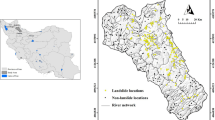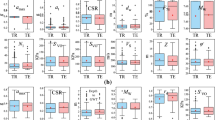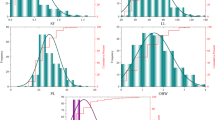Abstract
Landslides refer to a wide range of processes that result in the downward and outward movement of slope-forming materials, which may spread. Estimating lateral spreading of soil is essential because of the complexities associated with the lateral spreading behavior. Existing empirical models for predicting liquefaction-induced lateral spread displacement are developed using a dataset that varied in terms of earthquake magnitude, source distance, ground slope, layer thickness, fines content, and grain size. The aim of this study is to increase the accuracy of earthquake-induced lateral spreading prediction using multigene genetic programming (MGGP), multilayer perceptron (MLP), and random forest (RF) model. MGGP, MLP, and RF model predictions of lateral spreading are compared with the results anticipated using machine learning techniques and conventional approaches. Results showed that the MGGP outperforms the Hamada, Youd, MLP, and RF equations for estimating maximum lateral displacement under free-face and gently sloping ground conditions according to the comparisons. The MGGP, which is proved to be better, was also utilized to estimate total lateral displacement for Adapazari data, along with machine learning techniques and conventional approaches.








Similar content being viewed by others
References
Acharyya R, Dey A (2018) Assessment of bearing capacity of interfering strip footings located near sloping surface considering artificial neural network technique. J Mt Sci 15:2766–2780
Alanis AY, Arana-Daniel N, Lopez-Franco C (2019) Artificial neural networks for engineering applications. Academic Press
Alipour A, Jafari A, Hossaini SMF (2012) Application of ANNs and MVLRA for estimation of specific charge in small tunnel. Int J Geomech 12:189–192
Ambraseys NN, Menue JM (1988) Earthquake-induced ground displacement. Earthq Eng Struct Dyn 16:985–1006
Archer K, Kimes RV (2008) Computational statistics & data analysis. Comput Stat Data Anal 52:2249–2260
Avval YJ, Derakhshani A (2019) New formulas for predicting liquefaction-induced lateral spreading: model tree approach. Bull Eng Geol Environ 78:3649–3651
Bartlett SF, Youd TL (1992a) Case histories of lateral spreads caused by the 1964 Alaska Earthquake. Buffalo, NY
Bartlett SF, Youd TL (1992b) Empirical analysis of horizontal ground displacement generated by liquefaction-induced lateral spreads. Buffalo, NY
Bartlett SF, Youd TL (1995) Empirical prediction of liquefaction-induced lateral spread. J Geotech Eng 121:316–329
Baziar MH, Ghorbani A (2005) Evaluation of lateral spreading using artificial neural networks. Soil Dyn Earthq Eng 25:1–9
Baziar MH, Saeedi Azizkandi A (2013) Evaluation of lateral spreading utilizing artificial neural network and genetic programming. Int J Civ Eng 11:100–111
Benbouras MA, Kettab RM, Zedira H et al (2018) Comparing nonlinear regression analysis and artificial neural networks to predict geotechnical parameters from standard penetration test. Urban Archit Constr 9:275–288
Bolandi H, Banzhaf W, Lajnef N et al (2019) An intelligent model for the prediction of bond strength of FRP bars in concrete: a soft computing approach. Technologies 7:42
Breiman L (2001) Random forests. Mach Learn 45:5–32
Breiman L, Cutler A (2005) Random Forests. Available at: http://www.stat.berkeley.edu/~breiman/RandomForests/. Accessed 15 Dec 2021
Cetin K, Youd TL, Seed RB et al (2002) Liquefaction-induced ground deformations at Hotel Sapanca during Kocaeli (Izmit), Turkey earthquake. Soil Dyn Earthq Eng 22:1083–1092
Chen Y, Xu C, Liu H, Zhang W (2015) Physical modeling of lateral spreading induced by inclined sandy foundation in the state of zero effective stress. Soil Dyn Earthq Eng 76:80–85
Chiru-Danzer M, Juang CH et al (2001) Estimation of liquefaction-induced horizontal displacements using artificial neural networks. Can Geotech J 38:200–207
Cutler A, Cutler DR, Stevens JR (2012) Random forests. Ensemble machine learning. Springer, Boston, MA, pp 157–175
Fu X, Li S, Fairbank M et al (2014) Training recurrent neural networks with the Levenberg–Marquardt algorithm for optimal control of a grid-connected converter. IEEE Trans Neural Networks Learn Syst 26:1900–1912
Gandomi AH, Alavi AH (2012) A new multi-gene genetic programming approach to nonlinear system modeling. Part I: materials and structural engineering problems. Neural Comput Appl 21:171–187
Garcia SR, Romo MP, Botero E (2008) A neurofuzzy system to analyze liquefaction-induced lateral spread. Soil Dyn Earthq Eng 28:169–180
Goh ATC (1996) Pile driving records reanalysed using neural networks. J Geotech Eng 122:492–495
Goh A, Zhang W (2014) An improvement to MLR model for predicting liquefaction-induced lateral spread using multivariate adaptive regression splines. Eng Geol 170:1–10
Hamada M (1992a) Large ground deformations and their effects on lifelines:1964 Niigata Earthquake. Buffalo, NY
Hamada M (1992b) Large ground deformations and their effects on lifelines:1983 Nihonkai-Chubu Earthquake. Buffalo, NY
Hamada M, Yasuda S, Isoyama R, Emoto K (1986) Study on liquefaction induced permanent ground displacement. The association for the development of earthquake prediction in Japan, Japan
Hamada M, Towhata I, Yasuda S, Isoyama R (1987) Study on permanent ground displacement by seismic liquefaction. Comput Geotech 4:197–220
Hamada M, Wakamatsu K, Ando T (1996) Liquefaction induced ground deformation and its caused damage during the 1995 Hyogoken-Nanbu Earthquake. Buffalo, NY
Hubick KT (1992) Artificial neural networks in Australia. CPN Publications, Canberra
Jain AK, Jianchang M, Mohiuddin KM (1996) Artificial neural networks. Computer (Long Beach Calif) 29:31–44
Javadi AA, Rezania M, Mousavi Nezhad M (2006) Evaluation of liquefaction induced lateral displacements using genetic programming. Comput Geotech 33:222–233
Jirdehi RA, Mamoudan HT, Sarkaleh HH (2014) Applying GMDH-type neural network and particle warm optimization for prediction of liquefaction ınduced lateral displacements. Appl Appl Math 9:528–540
Juang CH, Chen CJ (1999) CPT-based liquefaction evaluation using artificial neural networks. Comput Civ Infrastruct Eng 14:221–229
Kaya Z (2016) Predicting liquefaction-induced lateral spreading by using neural network and neuro-fuzzy techniques. Int J Geomech 16:04015095
Ko YY, Lin YY (2020) A comparison of simplified modelling approaches for performance assessment of piles subjected to lateral spreading of liquefied ground. Geofluids 2020:1–16
Koza JR (1994) Genetic programming as a means for programming computers by natural selection. Stat Comput 4:87–112
Lai J, Qiu J, Feng Z et al (2016) Prediction of soil deformation in tunnelling using artificial neural networks. Comput Intell Neurosci 2016:1–16
Li SH, Wu LZ, Chen JJ, Huang RQ (2020) Multiple data-driven approach for predicting landslide deformation. Landslides 17:709–718
Liu Z, Tesfamariam S (2012) Prediction of lateral spread displacement: data-driven approaches. Bull Earthq Eng 10:1431–1445
Luo J, Ren R, Guo K (2020) The deformation monitoring of foundation pit by back propagation neural network and genetic algorithm and its application in geotechnical engineering. PLoS ONE 15:1–15
Namdar A (2020) Forecasting bearing capacity of the mixed soil using artificial neural networking. Frat Ed Integrità Strutt 14:285–294
Oommen T, Baise LG (2010) Model development and validation for intelligent data collection for lateral spread displacements. J Comput Civ Eng 24:467–477
O’Rourke TD, Beaujon PA, Scawthorn CA (1992) Large ground deformation and their effects on lifeline facilities: 1906 San Francisco earthquake. Buffalo, NY
Pal M (2005) Random forest classifier for remote sensing classification. Int J Remote Sens 26:217–222
Pham TA (2021) Application of feedforward neural network and SPT Results in the estimation of seismic soil liquefaction triggering. Comput Intell Neurosci 2021:1–14
Rauch AF (1997) EPOLLS: An empirical method for predicting surface displacements due to liquefaction-induced lateral spreading in earthquakes. Virginia Polytechnic Institute
Rauch AF, Martin JR III (2000) EPOLLS model for predicting average displacements on lateral spreads. J Geotech Geoenvironmental Eng 126:360–371
Rezania M, Faramarzi A, Javadi AA (2011) An evolutionary based approach for assessment of earthquake-induced soil liquefaction and lateral displacement. Eng Appl Artif Intell 24:142–143
Rozveh S, Derakhshani A (2021) Uncertainty analysis of liquefaction-induced lateral spreading using fuzzy variables and genetic algorithm. Bull Eng Geol Environ 80:9185–9200
Searson DP (2015) GPTIPS 2: an open-source software platform for symbolic data mining. Handb Genet Program Appl 22:551–573
Searson DP, Leahy DE, Willis MJ (2010) GPTIPS: an open source genetic programming toolbox for multigene symbolic regression. Proceedings of the International multiconference of engineers and computer scientists. Citeseer, pp 77–80
Shahin MA, Jaksa MB, Maier HR (2001) Artificial neural network applications in geotechnical engineering. Aust Geomech 36:49–62
Shamato Y, Zhang JM, Tokimatsu K (1998) New charts for predicting large residual post-liquefaction ground deformation. Soil Dyn Earthq Eng 17:427–438
Singh TN, Kanchan R, Verma AK, Singh S (2003) An intelligent approach for prediction of triaxial properties using unconfined uniaxial strength. Min Eng J 5:12–16
Smith C (2017) Decision trees and random forests: a visual introduction for beginners. Blue Windmill Media
Smits GF, Kotanchek M (2005) Pareto-front exploitation in symbolic regression. In Genetic programming theory and practice II. Springer, Boston, MA, pp 283–299
Sulewska MJ (2010) Neural modelling of compactibility characteristics of cohesionless soil. Comput Assist Methods Eng Sci 17:27–40
Tarefder R, Ahsan S, Ahmed M (2015) Neural network–based thickness determination model to improve backcalculation of layer moduli without coring. Int J Geomech 15:04014058
Wang J, Rahman MS (1999) A neural network model for liquefaction-induced horizontal ground displacement. Soil Dyn Earthq Eng 18:555–568
Wang HB, Xu WY, Xu RC (2005) Slope stability evaluation using back propagation neural networks. Eng Geol 80:302–315
Watts JD, Powell SL, Lawrence RL, Hilker T (2011) Improved classification of conservation tillage adoption using high temporal and synthetic satellite imagery. Remote Sens Environ 115:66–75
Yilmaz I, Kaynar O (2011) Multiple regression, ANN (RBF, MLP) and ANFIS models for prediction of swell potential of clayey soils. Expert Syst Appl 38:5958–5966
Youd TL, Perkins DM (1987) Mapping of liquefaction severity index. J Geotech Eng 113:1374–1392
Youd TL, Hansen CM, Bartlett SF (2002) Revised multilinear regression equations for predicting of lateral spread displacement. J Geotech Geoenvironmental Eng 128:1007–1017
Youssef MA, Hashash PE, Marulanda C et al (2006) Novel approach to integration of numerical modeling and field observations for deep excavations. J Geotech Geoenvironmental Eng 132:1019–1031
Zhang J, Zhao JX (2005) Empirical models for estimating liquefaction-induced lateral spread displacement. Soil Dyn Earthq Eng 25:439–450
Zhang G, Xiang X, Tang H (2011) Time series prediction of chimney foundation settlement by neural networks. Int J Geomech 11:154–158
Zhang W, Wu C, Zhong H et al (2021) Prediction of undrained shear strength using extreme gradient boosting and random forest based on Bayesian optimization. Geosci Front 12:469–477
Zhang W, Zhang R, Wu C et al (2022) Assessment of basal heave stability for braced excavations in anisotropic clay using extreme gradient boosting and random forest regression. Undergr Sp 7:233–241
Author information
Authors and Affiliations
Corresponding author
Ethics declarations
Conflict of interest
The authors declare no competing interests.
Rights and permissions
Springer Nature or its licensor (e.g. a society or other partner) holds exclusive rights to this article under a publishing agreement with the author(s) or other rightsholder(s); author self-archiving of the accepted manuscript version of this article is solely governed by the terms of such publishing agreement and applicable law.
About this article
Cite this article
Kaya, Z., Latifoglu, L., Uncuoglu, E. et al. Predicting liquefaction-induced lateral spreading by using the multigene genetic programming (MGGP), multilayer perceptron (MLP), and random forest (RF) techniques. Bull Eng Geol Environ 82, 84 (2023). https://doi.org/10.1007/s10064-023-03103-9
Received:
Accepted:
Published:
DOI: https://doi.org/10.1007/s10064-023-03103-9




